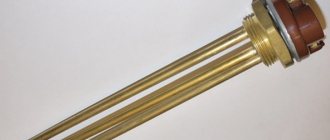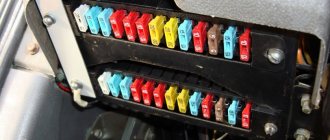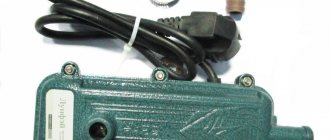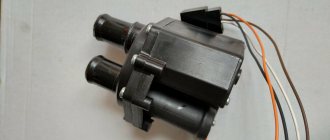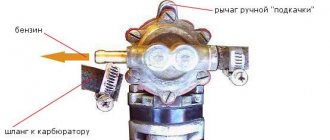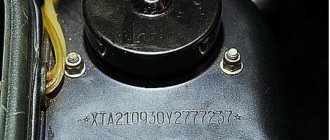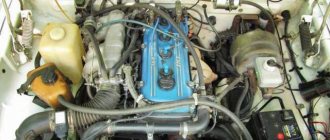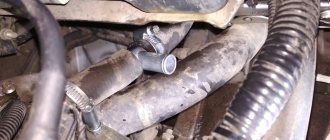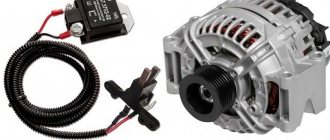Start-Classic for GAZelle Business with UMZ 4216 engine
Installation kits have been developed for all heaters of Leader JSC.
They can come in a single package with a heater or be sold separately. The installation kit is a set of all necessary parts for installation. Everything is at hand! No need to run to the store and urgently look for spare parts! Each installation kit is supplied with detailed installation instructions with photographs. By following its requirements, you can install the heater yourself. As practice shows, even self-installation takes only 2-4 hours (even faster for professionals at service stations). You can also find instructions for installing heaters right now on the website. Select the installation kit number or car brand you are interested in. Heating severs operates from 220 V. It is connected to the engine cooling system, fluid circulation occurs by changing the heating temperature of the fluid.
Cut the rubber sleeve into lengths: output sleeve L2 = 480 mm; inlet sleeve L1 = 190 mm.
Secure the bracket to the heater with studs through the bushings using washers and nuts
Place the sleeves on the corresponding heater pipes and secure the connections with clamps.
Install the spring from the kit into the inlet sleeve.
Remove the Gazelle Next engine protection.
Disconnect the air intake pipe.
Provide access to the plug in the engine head: disconnect the inlet hose from the engine; Unscrew the fastening of the interior heater pipe at the rear of the engine; disconnect the interior heater pipe hose from the engine; Unscrew the oil dipstick tube.
Start-Classic for GAZelle Business with UMZ 4216 engine
Start-Classic is designed for pre-heating of coolant in internal combustion engines of vehicles and units during the cold season.
Operating principle of the electric heater: Coolant (antifreeze, antifreeze) is heated in the heater housing. Due to the lower density, the heated liquid begins to circulate directionally and enter the engine cooling jacket. The place of the heated liquid is taken by a colder one. This establishes natural thermosyphon circulation of the coolant. The thermostat automatically maintains the coolant temperature within specified limits and allows the heater to be used not only to warm up a cold engine, but also to keep it warm during the cold season and constantly ready to move. The engine warm-up time depends on climatic conditions (temperature, wind), as well as on the parking conditions of the car (open parking, garage). Installation and maintenance: The electric heater is built into the engine cooling system of domestic and foreign cars (external installation method), power supply from a 220 V mains voltage. It is recommended that the electric heater be installed at a car service station. Due to their simple design, electric heaters do not require frequent maintenance (see Operating Manual). Technical data of the electric heater:
Installation recommendations:
Photo example of installation:
Advantages:
1) The vertical design allows for more convenient placement of the electric heater in the densely packed engine compartment of modern cars;
2) The ball valve ensures the direction of coolant circulation, protects the electric heater from overheating and makes heating more efficient with various installation schemes; 3) The thermostat ensures that the electric heater is turned on and off within specified temperature limits, which protects the device from overheating and saves energy. Advantages when using:
Superiority:
Delivery of purified water
A profitable business idea for Gazelle in 2021 could be the delivery of clean drinking water. The bottled water market is growing annually by 15-20%. Coolers are installed in schools, kindergartens, offices, fitness centers, and industrial premises. Water has to be delivered once every 2-3 days, to some points - daily.
Read also:
DIY home business ideas
Pros of the idea:
- perfect for Gazelle;
- does not require refrigeration or other equipment (water is a non-perishable commodity, its shelf life is 3 months);
- information about consumers will allow you to create the optimal route and save time.
Minuses:
- It takes time to find and create a customer base.
For the end consumer, the cost of a bottle with a volume of 18.9 liters is from 130 rubles, net profit (margin) is 50-60 rubles. To launch a startup, it is advisable to purchase a stand for manually carrying bottles - it will cost 500 rubles. and will give you the opportunity to save on the loader. If you sell 100 bottles daily, your income will be 5,000 rubles. per day (110,000 rubles per month). We subtract the monthly vehicle maintenance costs - what remains is a net income of 86,800.
Diagram of the heater, preheater/reheater for the GAZelle Next heating system.
Diagram of the heater, preheater/reheater for the GAZelle Next heating system.
A feature of the diesel engine is its inability to maintain a high operating temperature when operating at idle speed, as well as at low load. This is especially pronounced in the winter season. As a result, engine parameters deteriorate (increased fuel consumption and wear of friction units) and the efficiency of the interior heating system decreases. To eliminate these shortcomings, as well as to make it easier to start the engine in cold weather, a pre-heater/reheater for the heating system will be used.
Heater/reheater device.
1 – air intake; 2 – air blower; 3 – liquid outlet pipe; 4 – glow pin/flame sensor; 5 – evaporative gasket; 6 – connectors; 7 – control unit with temperature sensors; 10 – heat exchanger; 11 – combustion chamber; 12 – Exhaust gas outlet; 13 – fuel intake; 14 – Circulation pump; 15 – liquid intake pipe; 16 – fuel metering pump.
On Gazelle Next, the heater is turned on (with the engine and heating system running) using a button on the front panel. The heater operates in automatic mode. Heats the coolant to a temperature of 80... 85˚ C. It is recommended to turn it on at an ambient temperature of +5˚ C and below.
Preheater switch.
1 – reheater switch.
The pre-heater mode is activated using a timer or remote control. The timer sets the moment the engine starts and the duration of operation.
Remote Control.
1,2 – navigation; 3 – turning on the autonomous heater in timer mode; 4 – heater switching on; 5 – selection of heater operating mode.
Electrical circuit diagram of the heater, pre-heater/reheater of the heating system.
1 – heater remote control; 2 – heater switch; 3 – heater relay; 4 – relay and fuse box in the passenger compartment; 5 – resistor; 6 – fan; 7 – gear motor of the “legs-chest” damper; 8 – gear motor of the “heat-cold” damper; 9 – recirculation damper gearmotor; 10 – electric crane; 11 – generator; 12 – reheater switch; 13 – fuel pump; 14 – relay for turning on the reheater; 15 – diagnostic connector; 16 – control panel; 17 – electric pump; 18 – additional heater; F42 – relay and fuse box in the passenger compartment; F44 – relay and fuse box under the hood; XP 25/229-С – block connecting harness 25 (along the cabin) with harness 229 (along the panel), gray ; ХР 25/229-Ч – block connecting harness 25 (along the cabin) with harness 229 (along the panel), black.
Delivery to stationary retail outlets
The traditional idea of the Gazelle business - delivery from small manufacturers to stationary retail outlets - will not disappear in 2021. Small-sized freight transport is of interest to small firms and manufacturing enterprises. Custom-made furniture, the production of paving slabs, small confectionery factories - in a large city there are enterprises that are ready to entrust the delivery of a Gazelle cargo truck.
It is important to know! Constant cooperation with 3-4 such companies will provide work for 6-8 hours a day and will become a source of stable income.
Description and characteristics of the engine
Cummins Inc's priority has been and remains to support the following features of its products:
Cummins ISF2.8 engine on the Gazelle Next truck
“Gazelles” are equipped with Cummins ISF2.8 engines, which fully possess these qualities and are perfect for light-duty trucks weighing up to 3.5 tons. The cars are in demand, despite the higher price than their gasoline-powered counterparts. Due to the low operating costs of a diesel engine, the difference in cost quickly pays off.
What is an engine? This is a 4-cylinder in-line turbocharged diesel engine for the Gazelle. It is unpretentious in terms of fuel quality and has good maintainability. The manufacturer claims a resource of 500 thousand kilometers. The cylinder block and cylinder head are made of high-strength gray cast iron, the liners are milled, have medium fixation, and can be replaced in case of wear or damage. The pistons are composite: the skirt is aluminum, and its upper part is made of an alloy that is resistant to high temperatures.
Cummins ISF2.8 engine cylinder block
Valve seats and guides are pressed into the block head, which increases maintainability. Each cylinder has four valves with chrome-plated rods made of heat-resistant alloys. For the exhaust valves, powerful springs are installed, which include chromium and silicon. The fuel system electronically controls the amount of fuel supplied to the injectors. High pressure (up to 1800 bar) is provided by a pump.
The first filter performs coarse fuel cleaning, the second – fine. Next are the slot filters. A system for removing water from fuel is also provided. During such cleaning, it is allowed (although not recommended) to refuel with low-quality diesel fuel. The injection is divided into two stages - preliminary and main, this method improves the combustion of the mixture. The nozzles are located in the central parts of the heads.
The Cummins ISF2.8 cooling system is configurable to operate under different temperature conditions. Operation of Gazelle-Business is permissible at temperatures up to +45 °C.
The system must be filled with high quality coolants (Shell brand and similar). To avoid rapid wear of the pump, do not fill with water or antifreeze that is not specified in the instruction manual. The system uses a large volume radiator, and it is possible to heat the intake manifold.
Cummins ISF2.8 engine cooling system
Cummins ISF2.8 engines have a modular architecture, which makes it easy to upgrade individual elements. In the future, it is expected to reach the level of the Euro-5 environmental standard.
Source
Drawing conclusions, summing up
Making money on pure cargo transportation is becoming more difficult every year. To generate income from personal transport, they invent new ideas, combine delivery business with other types of commerce, and use the Internet to promote and find customers. Express delivery of perishable goods for an eco-food store, trips to neighboring countries, delivery of packaged goods to consumers at small wholesale prices - the bank of ideas is replenished with new interesting directions from year to year. However, it is worth remembering: whether an idea is good or bad, it can only be assessed using real numbers.
Table 1. Comparative characteristics of GAZ models
| Model | Load capacity, in tons | Body length, m | Peculiarities |
| Onboard | 1.5 | 3.2 m | the body is not limited in height |
| side extended (there is an option with an awning) | 1.5 | 4.3 m | |
| with awning | 1.5 | 3.2 | maximum cargo volume 9.6 cubic meters. m |
| Van: | |||
| standard | |||
| 1.5 | 3.2 | equipped with door and lock | |
| extended | 1.5 | 4.3 | |
| high | 1.5 | 3.2 | body height 2.2 m |
| Farmer | 1 | 3.2 | has a six-seater cabin for passengers and an open body for transporting animals |
Table 2. Highly specialized Gazelle bodies for certain types of cargo
| Van type | Purpose | Average cost of transportation in rubles per hour |
| 1. Isothermal | for transporting food, ensures the preservation of temperature conditions due to the insulation of the walls with polyurethane foam | 400 |
| 2. Refrigerator | equipped with a refrigeration unit that operates for cooling and heating | 550 |
| 3. All metal | the low floor level and the presence of a side door make loading more convenient; The driver's cabin is not separated from the cargo compartment | 400 |
| 4. Pyramid | suitable for transporting glass, equipped with holding straps | 550 |
| 5. Furniture | oversized body (up to 10 cubic meters) with a rigid metal compartment, soft upholstery and additional equipment | 450 |
Heaters "Start"
Most often, car owners give preference to Russian-made devices, including Start heaters, manufactured in Tyumen.
Such decisions are due to the fact that the products are of fairly good quality, cope with the assigned tasks, the devices are inexpensive, and installing them on a car is not difficult.
The range of heaters is quite extensive. It includes models with different capacities, providing both forced and gravity circulation of coolant through the system during operation.
In general, the operating principle of preheaters is very simple. There is a housing with leads for connection to the cooling system pipes. Inside this housing there are heating elements - heating elements.
In fact, the operation of the heater is no different from a conventional boiler. The only thing is that devices with a pump additionally have an electric motor with an impeller, which forcibly ensures the movement of the liquid. In gravity-flow devices, circulation is carried out due to temperature differences.
Outbound trade
In Russia, outbound sales can become an interesting business using Gazelle. In small towns where there are no supermarkets and the range of local retail outlets is limited, “Gazelle” with fresh meat, bread, and milk is sure to cause a rush of demand.
Read also:
Advertising agency: how and where to start your business
Business nuances. It is required to collect a package of documents: certificates from the manufacturer for the products, a trade permit from the local authorities. In addition, the tax inspectorate insists that outbound trade must be conducted through a cash register (cash register) - this issue has not yet been resolved; each region has its own requirements.
Important information! A promising idea is trade in country and cottage villages. Prosperous people live here - they are accustomed to the variety of city stores, but are deprived of the usual range of goods outside the city limits.
Models, their features
The “Start” line of preheaters includes the following series:
"Start"
Classic horizontal tank-type heaters with high power (2.5 and 3.0 kW). The movement of liquid in them is gravity. Designed for installation on trucks;
"Start-Turbo"
The only series of tank heaters equipped with a centrifugal pump providing forced circulation. They are mounted on the car in a vertical position, the terminals for connecting to the system are located perpendicularly. The series includes three sets - “Universal No. 1” (with a power of 1.0 kW, 1.5 kW and 2.5 kW.
The set contains components for a sequential installation method), “Universal No. 2” (heaters of the same power, but the set contains a variety of elements for installation, which allows you to make an insert in different ways) and “Universal No. 3” (the kit contains the same components, same as set No. 1, but the device itself is different - its power is 3 kW). These devices are suitable for use on both cars and trucks;
"Start-Classic"
Vertical gravity tank heaters. Models are available with two powers - 1.5 and 2.0 kW. They are intended for use on passenger car engines;
"Start M"
Gravity reservoir devices having a horizontal design. The power of the devices is 1.5 and 2.0 kW. They are intended for mid-size GAZ and ZIL trucks, but are often used by owners of passenger cars. One of the models is equipped with a bumper connector;
"Start M1" and "Start M2"
Low-power flow-type heaters. Models M1 (power 0.6 kW) are designed for installation on VAZ engines (the design of the cooling system of which uses a shortened supply pipe). And M2 heaters are designed for use with GAZ car engines. Their power is 0.7 kW;
"Start MP"
A series of low-power flow-through heaters (0.7 kW). Includes three models that differ in the diameters of the connection pins (26 mm, 32 mm and 39 mm). This series is suitable for use on cars, trucks and any other vehicles with a liquid cooling system (for example, snowmobiles);
Each heater model is equipped with everything necessary (adapters, tees, mounting brackets, clamps, rubber tubes) for installation work. There are also options when devices are sold without any additional components in the set.
To maintain the temperature regime, thermal switches are used in the design of the heaters, which eliminates the possibility of overheating of the heating element and its failure.
Installation methods
The method of installing the device can be very different, so you should carefully study the instructions before starting installation. For many models, when inserting, it is necessary to strictly observe the placement of the device relative to the engine. Otherwise, the circulation of liquid (especially in gravity models) may be disrupted and the device will not be able to fully perform its functions.
Let's look at the most common methods of installing pre-heaters on cars. Since the “Start” model is structurally and externally identical to the “Start M” versions (the difference is only in size and power), we will consider installation using the example of the latter (they are often preferred by car owners).
Installation of the Start M engine heater according to the instructions is carried out in a parallel circuit. The peculiarity of this scheme is that antifreeze is supplied for heating from the cylinder block.
To do this, instead of a drain plug, a special adapter fitting is installed on the block. In some cases, a plug on the block can be used for supply (in some kits with a heater there is an identical plug, but with a hole for a fitting). The heated liquid is drained into the upper pipe leading from the radiator to the engine.
What is it intended for and how is it designed?
When the engine starts after a long stop, in the first seconds its parts come into contact with each other without lubrication. The viscosity of cold engine oil is higher than in the operating temperature range of the engine. Therefore, it takes some time for the lubricating fluid to penetrate through narrow oil lines to engine parts. Parts of the piston group especially suffer from cold starts. Thus, starting cold motors reduces their service life by up to 1.5 times. In order to avoid this, as well as to make it easier to start the engine in frosty weather, pre-start heaters are designed, powered by a 220 V network.
This device can heat up the engine in 30 minutes even in severe frost
Design and operation of the preheater
A modern heater is designed quite simply and is not much different from a boiler. The principle of its operation is to heat the coolant (antifreeze, antifreeze) to operating temperature, from 60 to 70 °C. When heated, the liquid begins to move through the pipes of the cooling system, heating the engine parts. To speed up heat transfer, many models are equipped with pumps that create pressure in the small circuit of the cooling system.
To create pressure due to temperature differences, heaters without a pump are connected to the cooling system at its lowest point. A device with a pump can be connected to the cooling system anywhere. When the temperature reaches the set value, the relay will simply turn off the heating element. If the temperature drops again, the relay will turn on the antifreeze heating again. Thus, you can connect the device in advance without fear of overheating the coolant.
In addition to heating the engine cooling jacket, heaters can parallel:
This way you can connect heaters with or without pumps
The power of the heating elements ranges from 500 Watt to 4 kW. The range of additional features depends on the model and complete set of each device. There are also quite simple heaters on sale that are screwed into plugs or drain plugs of engine cooling systems.
Scope of application and variety of models
A simple device and low cost are the main advantages of 220 volt preheaters over other varieties. These devices can be independently installed on any car. You just need to decide on how to mount the device in the engine compartment and follow the manufacturer’s installation instructions. The only condition limiting the scope of application is the mandatory presence of an electrical outlet nearby.
Other types of preheaters
In addition to electric heaters, other devices are also produced that differ in their operating principle. Their main advantage is complete autonomy of operation.
Autonomous engine heaters
Devices of this type run on the same fuel as car engines. The advantage of autonomous devices is that they can heat up the power unit anywhere without requiring an additional energy source. This quality is important when operating vehicles in remote areas of Siberia and in other places where there is no close access to sources of electricity. The disadvantage of autonomous pre-heaters is their more complex design and high price compared to electric ones. In addition, they are more difficult to install due to the greater number of communications, as well as larger dimensions and weight.
Autonomous devices can run on gasoline and diesel fuel
Video: operation, advantages and disadvantages of autonomous heaters
Thermal accumulators
The design is a large thermos that retains the heat of heated coolant for up to two days. When it is necessary to start the engine, the electric pump is turned on, which pumps hot antifreeze into the small cooling circuit. In this case, the engine heats up in just a few minutes. The advantage is autonomy and no need for additional energy. The disadvantage is the large volume of the structure. Such batteries, under the trademarks “Gulfstream”, “Avtotherm” and others, are produced in Russia.
The heat accumulator is a double-hulled cylindrical vessel with highly efficient vacuum-powder insulation
Diesel fuel heaters
In addition to devices that heat engines, models are also produced that heat the fuel systems of diesel engines. In severe frost, diesel fuel may thicken so much that the diesel engine cannot be started. Such heaters heat diesel fuel to an acceptable temperature. Powered by batteries, DC voltage 12 V. Such devices, Nomakon brand, are produced in Belarus. They are produced in several modifications, installed in different components of the fuel system.
The devices are simple in design, easy to connect and inexpensive
Cargo taxi
The simplest idea today is to register with a dispatch service that works like a taxi. It’s convenient to work on orders that are found by specially trained people. There are similar mediation services in every city.
- Pros: the dispatcher creates a flow of clients, there are no advertising costs, there is no downtime, no time is wasted searching for customers, you can register with several similar organizations at once.
- Cons: income from one order is reduced, since part of the earnings (10-15%) will have to be given to an intermediary.
Another idea for organizing a business without hassle is to become a partner of one of the transport companies (TC) operating in Russia and the CIS countries. They are interested in a small transport with a driver who will transport the cargo from the TC branch directly to the destination, and offer loyal conditions for cooperation.
Read also:
Open-air cinema: the whole truth about the new super-profitable business
Instructions for installing pre-heaters on a VAZ-2190 Granta car
Below we will present the installation of pre-start heaters (boilers) “Severs-M” and “Start-M” on a Lada Granta car, with different schemes for inserting into the cooling system.
How to install the Start-M heater on a Lada Granta with a cable-driven gearbox (16V)
You must first purchase the “Start-M” kit specifically for this brand of car. At the end of the packaging box there is a list of models. Granta should be marked there along with a note about the cable drive and automatic transmission (16-valve injection engine). This is due to a design feature - in this version, the starter closes the coolant drain hole in the engine. Therefore, it will not be possible to screw the adapter into it. You will have to make an insert into the lower radiator pipe and into the hose going to the stove. To do this you will need two tees. You can purchase a modification kit with an 8-valve engine and a rocker gearbox, but you will also have to buy a tee measuring 33 x 33 x 16.
The kit should contain the following parts:
To prevent antifreeze from leaking, when installing hoses, the fittings must be lubricated with sealant
As soon as the stove pipe is cut, it is better to immediately attach clamps to both ends without clamping them
Video: installation of the Start-M pre-heater on a Lada Granta car
How to install the Severs preheater on a VAZ-2190 Granta with a manual transmission rocker drive (v8)
The Granta engine compartment with an 8-valve engine and a manual transmission, which is controlled not by a cable, but by a rocker, is slightly different in design. The starter is located differently than in the modification described above. The connection diagram for Severs with a power of 1.5 kW also differs from that described above. You need to purchase the boiler together with installation kit 32 for VAZ-2190.
The kit includes clamps, a sleeve, brackets, a tee and all the necessary fasteners
Before installation, you should prepare the necessary tools:
The work is carried out in the following sequence:
For installation, use the studs, bushings, washers and nuts included in the kit.
Before putting on the sleeves, you should lubricate the heater fittings with sealant
For fastening, use M6 x 60 bolts and locking nuts, or standard M6 bolts and nuts with washers
Before installing the tee, clamps should be placed on the ends of the pipe and the sleeve.
Flow-through heater with pump - installation
In principle, with a pump, everything is simpler, because you don’t need to go into the laws of physics - the pump does its job, and very well, most often the pump costs about 700 liters per hour.
Errors when installing a flow-through heater
1.
Parallel with the stove. Not a single flow-through heater has a check valve, so it is absolutely impossible to install it in parallel with the stove, because the liquid will circulate not through the radiator, but through the heater. If there are no other options, you need to install at least one tap either at the inlet or outlet of the heating.
2.
The outlet pipe must be strictly at the top. That is, it must be unfolded so that the pipes are aligned along the vertical axis. This is necessary so that the pump can expel air, otherwise the heating element will burn out.
3.
This point is rather advisory in nature. Do not turn the heater pump against the fluid circulation in the engine. This means that the heater installed in the return of the stove should push water into the pump, and not into the radiator. This is necessary so as not to accidentally start the engine with the heating running.
Can you imagine what will happen to the stove radiator or just the pipe if two pumps start pumping into it at the same time?
That's right, both of them will most likely be torn apart.
These are the simplest things that every car enthusiast should know. Subscribe to the channel to know. Well, give me a thumbs up, I will be pleased.

